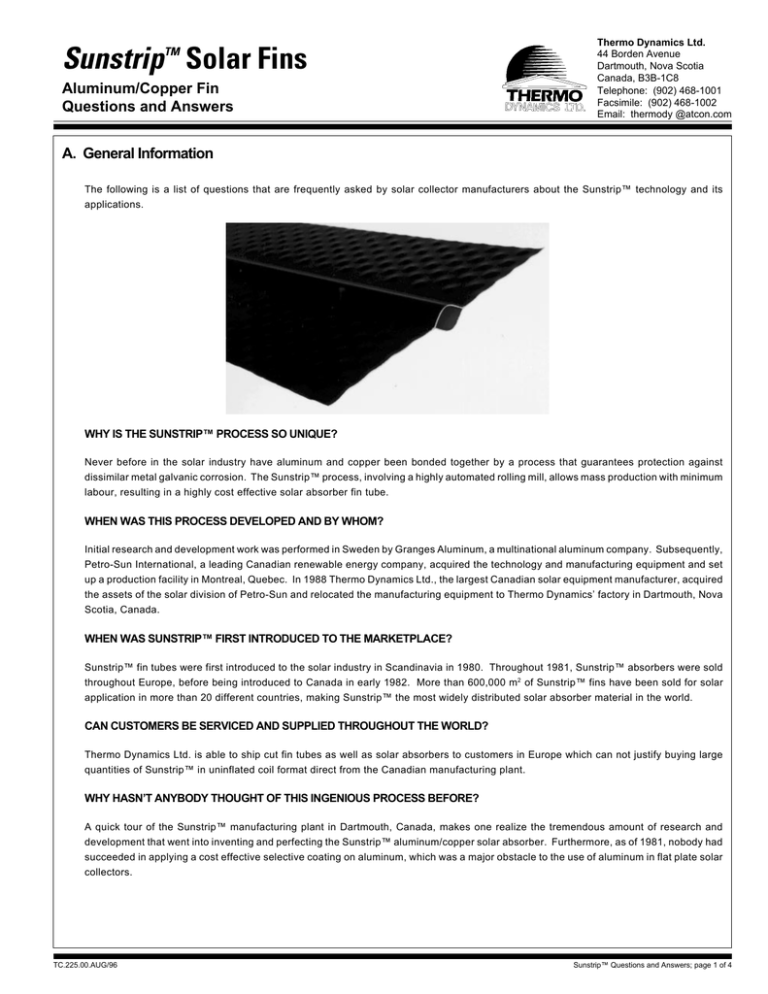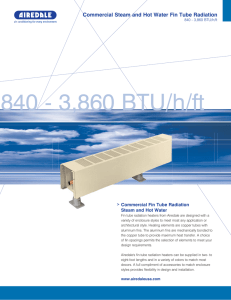Sunstrip Questions and Answers
advertisement

Sunstrip Solar Fins TM Aluminum/Copper Fin Questions and Answers Thermo Dynamics Ltd. 44 Borden Avenue Dartmouth, Nova Scotia Canada, B3B-1C8 Telephone: (902) 468-1001 Facsimile: (902) 468-1002 Email: thermody @atcon.com A. General Information The following is a list of questions that are frequently asked by solar collector manufacturers about the Sunstrip™ technology and its applications. WHY IS THE SUNSTRIP™ PROCESS SO UNIQUE? Never before in the solar industry have aluminum and copper been bonded together by a process that guarantees protection against dissimilar metal galvanic corrosion. The Sunstrip™ process, involving a highly automated rolling mill, allows mass production with minimum labour, resulting in a highly cost effective solar absorber fin tube. WHEN WAS THIS PROCESS DEVELOPED AND BY WHOM? Initial research and development work was performed in Sweden by Granges Aluminum, a multinational aluminum company. Subsequently, Petro-Sun International, a leading Canadian renewable energy company, acquired the technology and manufacturing equipment and set up a production facility in Montreal, Quebec. In 1988 Thermo Dynamics Ltd., the largest Canadian solar equipment manufacturer, acquired the assets of the solar division of Petro-Sun and relocated the manufacturing equipment to Thermo Dynamics’ factory in Dartmouth, Nova Scotia, Canada. WHEN WAS SUNSTRIP™ FIRST INTRODUCED TO THE MARKETPLACE? Sunstrip™ fin tubes were first introduced to the solar industry in Scandinavia in 1980. Throughout 1981, Sunstrip™ absorbers were sold throughout Europe, before being introduced to Canada in early 1982. More than 600,000 m2 of Sunstrip™ fins have been sold for solar application in more than 20 different countries, making Sunstrip™ the most widely distributed solar absorber material in the world. CAN CUSTOMERS BE SERVICED AND SUPPLIED THROUGHOUT THE WORLD? Thermo Dynamics Ltd. is able to ship cut fin tubes as well as solar absorbers to customers in Europe which can not justify buying large quantities of Sunstrip™ in uninflated coil format direct from the Canadian manufacturing plant. WHY HASN’T ANYBODY THOUGHT OF THIS INGENIOUS PROCESS BEFORE? A quick tour of the Sunstrip™ manufacturing plant in Dartmouth, Canada, makes one realize the tremendous amount of research and development that went into inventing and perfecting the Sunstrip™ aluminum/copper solar absorber. Furthermore, as of 1981, nobody had succeeded in applying a cost effective selective coating on aluminum, which was a major obstacle to the use of aluminum in flat plate solar collectors. TC.225.00.AUG/96 Sunstrip™ Questions and Answers; page 1 of 4 Sunstrip Solar Fins TM Aluminum/Copper Fin Questions and Answers WHAT IS THE ACTUAL PRODUCTION CAPACITY OF THERMO DYNAMICS’ MANUFACTURING PLANT IN CANADA? A capacity of some 225,000 m 2 / year is now possible on a two shift / day basis. WHO ARE THE CONSUMERS OF SUNSTRIP™ FIN? The Sunstrip™ cut-to-length and inflated fin tubes, as well as the coils, are sold exclusively to solar collector manufacturers. They in turn process the product into solar absorbers, before placing them in their own solar collectors and systems. WHAT IS THE PURCHASING PATTERN OF SUNSTRIP™ USERS? Usually collector manufacturers initially purchase inflated and pre-cut to-length fin tubes. However, as volume increases, it becomes more cost effective for them to purchase Sunstrip™ in uninflated coils, so as to be able to inflate and cut the fins to their specific requirements “in house”. The Sunstrip™ “inflating and cut to-length equipment” is offered to solar collector manufacturers directly from Canada. HOW WILL PRICES OF SUNSTRIP™ FIN TUBES BE AFFECTED WITH THE INFLATION OF ALUMINUM AND COPPER PRICES? Obviously, the prices will be adjusted according to the fluctuation of raw material prices. However, since prices of aluminum have been much more stable over time than the prices of copper, we are confident that the prices of Sunstrip™ fin tubes will fluctuate much less than the prices of comparable “all copper” solar absorbers. HOW CAN SUNSTRIP™ COILS AND FIN TUBES BE SHIPPED AROUND THE WORLD COST EFFECTIVELY? Thermo Dynamics Ltd. has shipped on numerous occasions 20 foot ocean containers overseas, with a high volume of products per shipment: · Approximately 5,000 m 2 of inflated and pre-cut-to-length fin tubes per 20 foot container. · Approximately 7,000 m 2 of uninflated coils of Sunstrip™ product per 20 foot container. For example, a 20 foot container from Halifax to Europe would cost approximately $2,000 Canadian, resulting in freight cost of only $0.29 CAD/m 2 of product shipped. WILL THERMO DYNAMICS LTD. HAVE THE CAPABILITY TO DELIVER LARGE VOLUMES WITHOUT DELAYS? Because of its current capacity of some 225,000 m 2 per year delivery for fin tubes or coils averages approximately four weeks, whereas delivery for finished absorber plates range from four to six weeks depending on the size of the order. IN WHAT OTHER HEAT EXCHANGER APPLICATION CAN THE SUNSTRIP™ FIN TUBE BE USED? Because of it’s exceptionally high heat transfer characteristics the Sunstrip™ fin tubes are used more and more in other “conventional” heat exchange process: · In Scandanavia, Sunstrip™ is used extensively in radiant heating and cooling systems, where the Sunstrip™ fins are installed on either vertical walls or on the ceilings. TC.225.00.AUG/96 Sunstrip™ Questions and Answers; page 2 of 4 Thermo Dynamics Ltd. 44 Borden Avenue Dartmouth, Nova Scotia Canada, B3B-1C8 Telephone: (902) 468-1001 Facsimile: (902) 468-1002 Email: thermody @atcon.com Sunstrip Solar Fins TM Aluminum/Copper Fin Questions and Answers B. Technical Questions and Answers HOW ARE THE ALUMINUM SHEETS BONDED TO THE COPPER TUBE IN THE ROLLING MILL OPERATION? Through a “cold welding” process, commonly known as cladding, the aluminum sheets and the copper tube are metallurgically fused together, resulting in the molecular bonding of both the aluminum and copper. WHAT ABOUT DISSIMILAR METAL OR GALVANIC CORROSION EFFECT BETWEEN THE ALUMINUM AND COPPER? Because of the perfect metallurgical bond, there is absolutely no possibility of air nor water being introduced between the aluminum and copper at any time during the life of the product. Unlike mechanical or pressure fits, where the aluminum fins are mechanically bonded to the copper tube, the Sunstrip™ process results in a perfect and continuous weld between the two metals, thus eliminating any galvanic corrosion surface areas. WAS THERE A TRADE-OFF IN THERMAL PERFORMANCE VS COST WITH THE USE OF ALUMINUM INSTEAD OF THE CONVENTIONAL ALL-COPPER FIN? No. The Sunstrip™ fin tube has achieved consistently better overall performances than conventional all copper and stainless steel absorbers with selective surfaces such as black chrome. SHOULD THE THICKNESS OF THE COPPER TUBE WALL BE INCREASED FOR ADDED DURABILITY? In order to reach the optimum cost/performance ratio, the research engineers have determined that a copper tube wall thickness of 0.30 is adequate for both long term corrosion protection as well as high burst pressure ratings. These conclusions were based on three year actual “in-the-field” testing, where solar collectors installed in different locations in Europe were brought back to the laboratory to be carefully analyzed and monitored, to see if any erosion or corrosion had occurred within the copper waterway risers and to determine if thermal and pressure cycling had any effect on the mechanical integrity of the Sunstrip™ fin tubes. WHY IS THE THERMAL PERFORMANCE OF SUNSTRIP™ ABSORBERS CONSISTENTLY HIGHER THAN THOSE OF OTHER ALL COPPER, BLACK CHROME SOLAR ABSORBERS? Even though aluminum is not as good a heat conductor as copper, independent laboratory testings are formal and clearly show the superior transfer of the Sunstrip™ fin tubes. These results are mainly due to the perfect heat transfer metallurgical bond that exists between the aluminum fin and the copper waterway as well as the fin configuration which yields a complete 360° “wrap-around” heat transfer profile between the fin and the heat transfer fluid. DURING THE FLATTENING OPERATION OF THE COPPER TUBE AND THE SUBSEQUENT ROLLING MILL PROCESS, ISN’T THERE ANY “WORK HARDENING” OF THE COPPER TUBE? The use of annealed copper tube ensures a finished product where residual corner stresses and the possibility of subsequent crevice corrosion have been eliminated. Examination of an inflated Sunstrip™ fin, with a sophisticated electron-microscope, clearly shows the stress free rearrangement of the copper molecules in the corners of the rhombic shape copper tube. TC.225.00.AUG/96 Sunstrip™ Questions and Answers; page 3 of 4 Sunstrip Solar Fins TM Aluminum/Copper Fin Questions and Answers HOW CAN A THIN WALL COPPER TUBE SUSTAIN HIGH OPERATING AND BURST PRESSURES? The combination of the copper tube and its aluminum cladding result in a tube with a burst pressure in the order of 6 MPa (870 psi), which is more than sufficient to guarantee the long life durability of any solar absorber, which in most instances would be operating between 0.2 MPa (30 psi) and 0.6 MPa (90 psi). WHAT SIZE OF COILS CAN ACTUALLY BE SHIPPED TO MANUFACTURERS? Coils range from 520 to 620 meters in length and weigh approximately 200 kg. HOW IS THE FIN TUBE CONNECTED TO THE SOLAR ABSORBER HEADERS? Using a simple and conventional brazing operation, a copper “nipple”, round at one end, rhombic at the other end, is brazed to a copper header or manifold. The Sunstrip™ fin is then soldered to the rhombic end of the copper nipple. This nipple ensures the transfer from the fin tube to the absorber header. The fact that a transfer “nipple” has to be used with the Sunstrip™ fin tubes is inherent to the nature of the continuous Sunstrip™ rolling mill operation. WHAT OTHER AREAS OF R & D IS THERMO DYNAMICS LTD. INVOLVED IN? Thermo Dynamics Ltd. has developed continuous “serpentine type” solar absorbers for solar domestic hot water applications. These conventional 2 or 3 m2 solar absorbers are made from one continuous Sunstrip™ fin tube, thus eliminating the need for any brazed connection between the riser tube and the two end headers. These absorbers have now been produced in large quantities and have undergone thermal performance testing and market evaluation. WHAT KIND OF INVESTMENT SHOULD ONE CONSIDER TO PURCHASE THE SUNSTRIP™ INFLATING AND CUTTING-TOLENGTH EQUIPMENT”? For a solar collector manufacturer that produces an average of 15,000 to 20,000 m 2 of solar absorbers/month, it becomes advantageous to own a Sunstrip™ inflating and cutting-to-length equipment. Prices for this equipment range from $20,000 to $35,000, depending on the options that are specified. C. What Type of Selective Surfaces are Available for Sunstrip™? The aluminum surface of the Sunstrip™ absorber plate lends itself to a low cost highly selective anodized surface coating. The Anodic/ Cobalt™ surface coating is applied in a twenty five minute operation which yields a surface with an absorptivity of 92% and an emissivity of 15%. This surface coating is available on cut and inflated lengths of Sunstrip™ up to 2.75 m (9 ft) long. Thermo Dynamics also offers a painted selective surface coating. The painted surface has an absorptivity of 98% and an emissivity of 45%. The painted surface can be applied to cut and inflated lengths of Sunstrip™ up to 7.6 m (25 ft) long. TC.225.00.AUG/96 Sunstrip™ Questions and Answers; page 4 of 4

